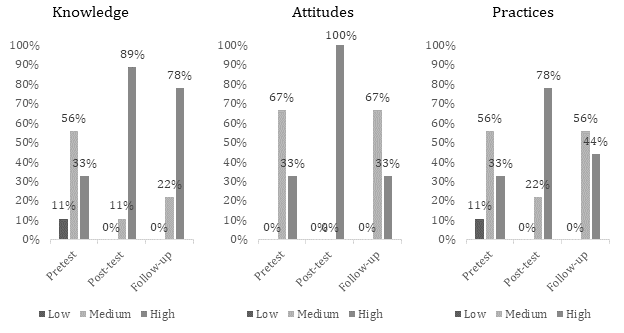Opening doors to life: A suicidal behavior prevention program involving Gatekeeper teachers
Abriendo puertas para la vida: Programa de prevención de conductas suicidas a través de docentes Gatekeepers
Abrindo portas para a vida: Programa de prevenção ao comportamento suicida por meio de professores Gatekeepers
Citation: Solarte MC, Araujo OL, Muñoz DF, Villalobos FH, Ceballos AK, Luna EG. Opening doors to life: A suicidal behavior prevention program involving Gatekeeper teachers. Univ Salud [Internet]. 2024; 26(2):A10-A18. DOI: 10.22267/rus.242602.325.
# Abstract
Introduction: Suicide is the third cause of death in young people aged between 15 to 19 years. Thus, school environments can promote mental health of adolescents through early identification of risk factors and prevention of suicidal behaviors. One prevention strategy is the training of “gatekeepers”. Objective: To determine the impact of the “Opening Doors to Life” program on the knowledge, attitudes, and practices regarding prevention of suicidal behavior in a set of high school teachers from an educational institution in San Juan de Pasto, Colombia. Materials and methods: A pre-experimental study with an intervention group and pre- and post-follow-up measurements. Nine volunteer teachers participated during two training sessions. Results: Positive changes regarding knowledge, attitudes, and practices of the participants during pretest and posttest were observed for the majority of evaluated sub-dimensions. However, after three years, the positive measures prevailed only for knowledge about suicidal behavior and attitudes toward prevention. Conclusion: The “Opening Doors to Life” program showed effectiveness and relevance. However, maintaining its impact requires follow-up actions and support of trained teachers.
Keywords: Suicide; program; teachers; students; mental health; referral and consultation. (Source: DeCS, Bireme).
# Resumen
Introducción: El suicidio es la tercera causa de muerte de jóvenes entre 15 y 19 años. Ante esto, los ambientes escolares pueden favorecer el fomento de la salud mental de los adolescentes, permitir la identificación temprana de factores de riesgo y aportar en la prevención de conductas suicidas. Una de las estrategias de prevención es el entrenamiento de “gatekeepers”. Objetivo: Determinar el efecto del programa “Abriendo Puertas para la Vida” sobre conocimientos, actitudes y prácticas en prevención de conductas suicidas en un grupo de profesores de secundaria de una institución educativa de San Juan de Pasto, Colombia. Materiales y métodos: Estudio preexperimental, con un grupo de intervención y medidas pre y pos-seguimiento. Participaron nueve docentes voluntarios durante dos jornadas de formación. Resultados: Se identificaron cambios positivos en conocimientos, actitudes y prácticas de los participantes entre pretest y postest, en la mayoría de las subdimensiones evaluadas; sin embargo, tres años después, estos cambios se mantuvieron tan solo en conocimientos sobre las conductas suicidas y en actitudes hacia la prevención. Conclusión: El programa “Abriendo Puertas para la Vida” evidenció efectividad y pertinencia, sin embargo, el mantenimiento de sus efectos requiere de acciones de seguimiento y acompañamiento a los docentes formados.
Palabras clave: Suicidio; programa; docentes; estudiantes; salud mental; derivación y consulta. (Fuente: DeCS, Bireme).
# Resumo
Introdução: O suicídio é a terceira causa de morte de jovens entre 15 e 19 anos. Diante disso, os ambientes escolares podem promover a promoção da saúde mental em adolescentes, permitir a identificação precoce de fatores de risco e contribuir para a prevenção do comportamento suicida. Uma das estratégias de prevenção é a formação de “gatekeepers”. Objetivo: Determinar o efeito do programa “Abrindo Portas para a Vida” nos conhecimentos, atitudes e práticas na prevenção do comportamento suicida em um grupo de professores do ensino médio de uma instituição educacional em San Juan de Pasto, Colômbia. Materiais e métodos: Estudo pré-experimental, com grupo de intervenção e medidas pré e pós-acompanhamento. Nove professores voluntários participaram durante dois dias de treinamento. Resultados: Foram identificadas mudanças positivas nos conhecimentos, atitudes e práticas dos participantes entre o pré-teste e o pós-teste, na maioria das subdimensões avaliadas; porém, três anos depois, essas mudanças se mantiveram apenas no conhecimento sobre comportamentos suicidas e atitudes frente à prevenção. Conclusão: O programa “Abrindo Portas para a Vida” mostrou efetividade e relevância, porém, a manutenção de seus efeitos requer ações de acompanhamento e apoio a professores capacitados.
Palavras chave: Atenção primária à saúde; promoção da saúde; prevenção primária; enfermagem. (Fonte: DeCS, Bireme).

